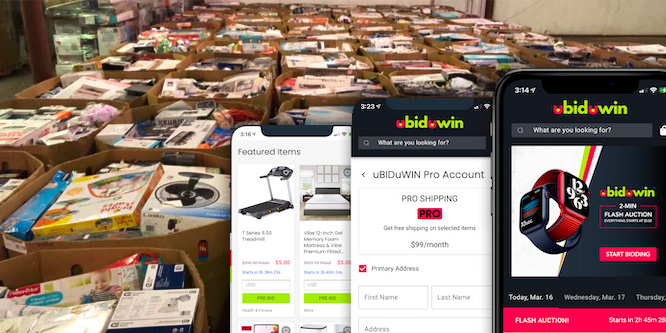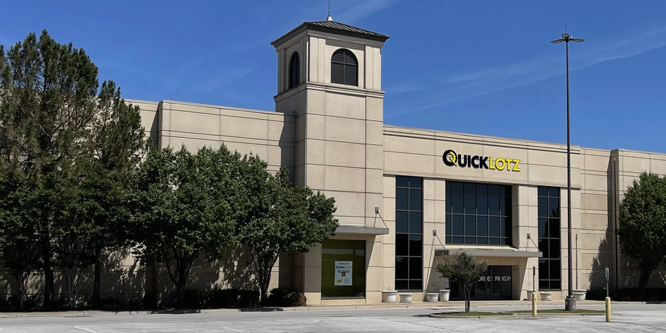
Photos: Quicklotz; ubiduwin.com
Could the ‘largest retail liquidation store’ change the discounting game?
Quicklotz Liquidations, which just announced plans to open the country’s “largest retail liquidation store,” is among a number of retailers mixing gamification and the treasure hunt experience to reinvent the liquidation process at brick and mortar retail.
Anchoring the Northeast Mall in Hurst, TX, the 140,000 square-foot store features a “bin shopping experience” offering more than 50,000 items daily at up to 90 percent off typical retail prices. The assortment consists of excess inventory from Walmart, Amazon.com, Nordstrom and others, including returns, shelf pulls, overstocks, closeouts, damaged merchandise and salvage.
The standout feature housed at the location, however, is ubiduwin — translating to “you bid you win” and described as “America’s fastest growing online auction.” Ubiduwin.com, which has more than 15,000 currently registered bidders, offers “fast, furious and fun” two-minute selling cycles with entry bids starting at $5.00. Winning bidders can pick up their items at the Hurst location or have them shipped anywhere in the U.S.

On the ubiduwin.com website, recent items available for bidding included a Coleman camping cot and air mattress with a retail value of $156 and a ProForm 50-lb. dumbbell with a retail value of $269. Quicklotz has six retail outlets overall.
The major trend in liquidation retailing is the daily descending price model.
Gimme A $5!, with 13 locations in the southeast, prices all items at $5 on Saturday and Sunday as locations are restocked. Prices are reduced to $3 on Monday, $2 on Tuesday, $1 on Wednesday and Thursday, and a quarter on Friday.
Crazy Cazboy’s, Krazy Binz, Good Deals, Dream Deals, Quarter 2 Five, BINge and Daily Dealz are some other banners making use of the daily price-drop concept.
Gimme A $5! says on its website that, beyond buying overstocks and returns in bulk, savings come from placing merchandise in bins to avoid the expense of organizing and stocking standard shelves. Setting one price daily eliminates the labor costs of pricing products individually.
The daily price-drop locations typically have lines outside on restocking days, with the deals promoted on social media.
Speaking to the Tennessean, Adam Harrington, a co-owner at Gimme A $5, said liquidators typically use sites like eBay to sell excess inventory, but items below $50 aren’t worth the time to photograph, pack and mail. He said, “They cycle the cheaper stuff over to us.”
- America’s Largest Retail Liquidation Store Opening Soon in DFW Market – Quicklotz Liquidations
- New store from massive discount chain lures Dallas bargain hunters – Culture Map Dallas
- Gimme A $5!
- Liquidation store digs up big business – Tennessean
- Dream Deals
- Is Crazy Cazboy’s pricing too crazy or just crazy enough? – RetailWire
- What Stores Do With $90 Billion in Merchandise Returns – The Wall Street Journal
Discussion Questions
DISCUSSION QUESTIONS: Is gamification, whether via flash auctions or the daily descending price model, uniquely suited to liquidation retailing, or can other types of retailers join in? Are liquidation stores becoming a better avenue to clear overstocks and returns versus online auctions, flea markets and other traditional reseller markets?


There are quite a few of these concepts across the U.S., cleaning down inventory from returns and such. The gamification aspect is very helpful in differentiating them from other discount outlets and is also a critical ingredient in driving traffic and creating urgency. I have also seen some where you buy unopened packages for a set amount without knowing what is in them, so it’s a bit like pot luck!
This is doubling down on the irresistible lure of the treasure hunt. The gamification aspect could add value to the origin stores in that people may feel prompted to better familiarize themselves with what a brand looks and feels like in a store so they can spot the real value in a fast paced bid or discount grab environment. I think consumers will ultimately be the big winners here, but it could send retail another step closer towards a commodity pricing downward spiral.
Gamification has been tapping into retail for quite some time and it’s a great way to engage customers, whether they are discount shoppers or not.
Liquidators have their work cut out for them as retailers are still playing catch up on getting back to their seasonal cycles. As stores are reopening, the excess inventory and markdown products are taking valuable space so a liquidator is a great option to help them exit out of excess.
Fundamentally, retail needs to change its buying model as excess is not good for the planet and we continue to overbuy and overproduce. That being said, this change is not going to happen anytime soon so it’s a bargain hunters paradise right now.
I like this idea. This is a really clever differentiator by QuickLotz that really plays well to one of the core value propositions of this segment, the treasure hunt. I think this will be successful.
Online returns are a massive and growing problem for retailers and manufacturers. Adding gamification to a treasure hunt scenario will certainly grab attention. Whether it will last over time remains to be seen.
Gamification is simply another way to sell products that online retailers like Woot! have been doing for years. Building a game concept into the operating platform to shift the focus will have little to no benefit.
Gamification puts the lure of the treasure hunt on an exponential curve. It’s experiential discounting and liquidating. What a hoot! Now imagine if retailers someday figure out how not to over buy their inventory — every season, year after year.
I love a deal hunt, but there’s still something to be said for dividing merchandise into categories. Most people don’t have time to tune into a flash sale unless there’s a chance of getting something they really need.
Sharing deals on social media is a great start. But I’d still like to see sales that are divided by category to make it a realistic time investment for more deal-hunters.
Close-out stores have a long history. In my opinion they didn’t scale very well because the supply of interesting good quality merchandise from manufacturer overruns and the so-called “gray market” was limited and they filled in the assortments with junk.
A potential big difference today is the immense quantity of merchandise from online returns. There is a substantial market for refurbished electronics and mobile phones, for example, and companies like goTRG that specialize in receiving, inspecting and reselling those items online. I doubt many of those goods are accessible to online retail liquidation stores.
But the uBiduWin online game show will certainly appeal to some shoppers, and the ever-changing mix of odd lot items can be entertaining. (The markdown model of descending prices was pioneered (I believe) in the 1960s by the Syms apparel stores in metro New York, which advertised the technique to inspire competitive feeling among its shoppers. That might be regarded as the earliest form of gamification in retail.)
Entertaining or not, I believe online mini-auctions and pricing games will deliver good values for a few and mediocre value for the rest, especially where shipping costs are factored in. For those shoppers lucky enough to live near QuickLotz, the treasure hunt can pay off now and then. Low product acquisition costs will allow attractive gross margins for the retailer, but a great deal of dusty inventory will likely undercut the net.
Mainstream retailers should probably steer clear, as the supply will never be consistent enough.
Let’s be honest, this is not a treasure hunt. This is a hunt for castoffs’ castoffs. There’s a market for this, but it is not main stream retail.